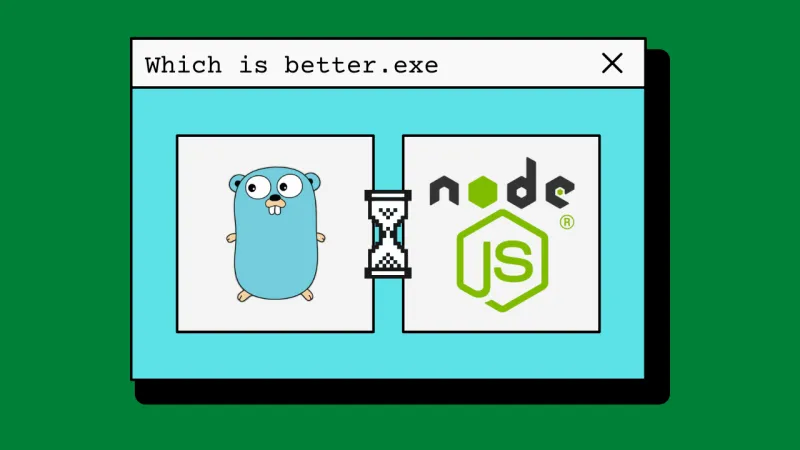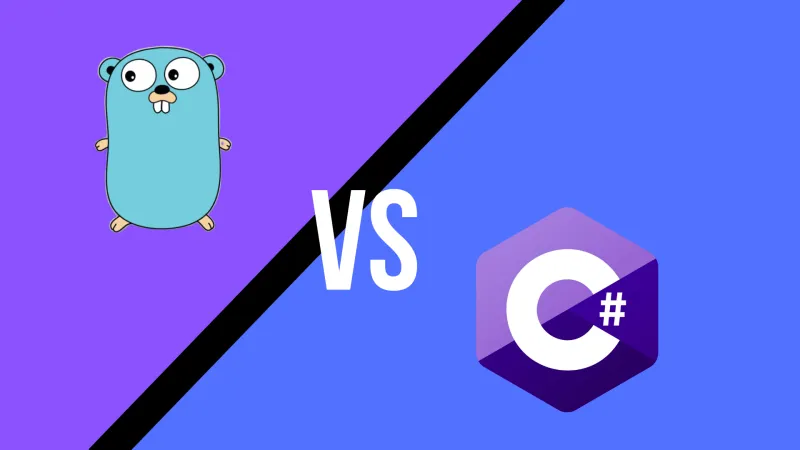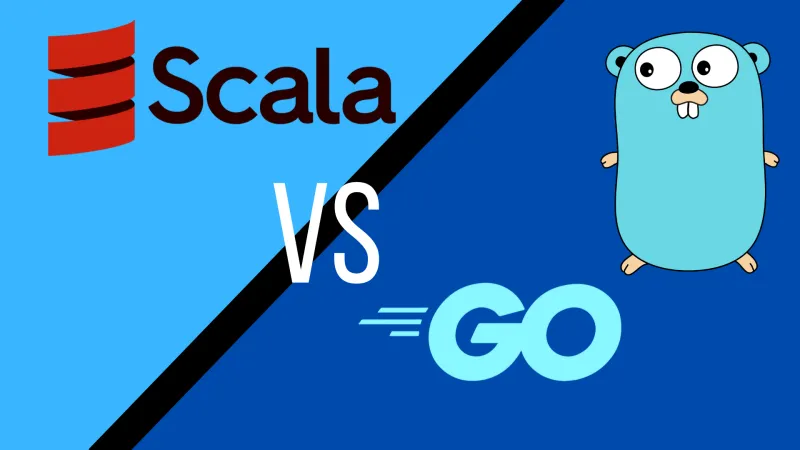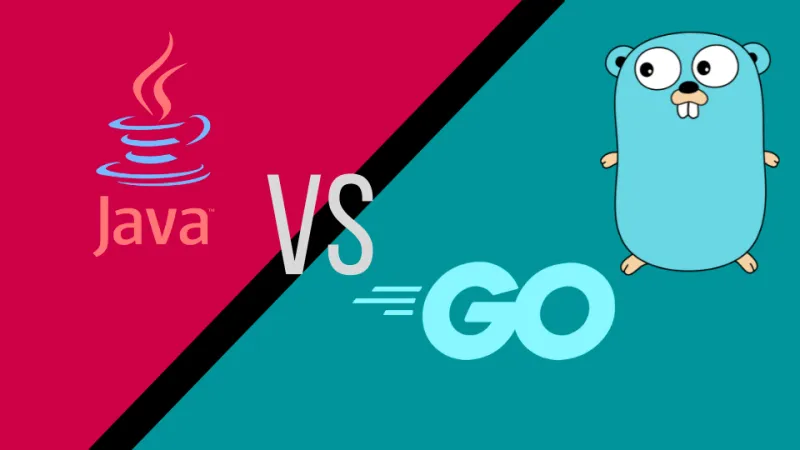In 2009, the computer science world was blessed with two powerful tools: Golang and Node.js.
Golang is a procedural, multiparadigm, open-source programming language, created by Google developers that were unhappy with the existing languages. C, C++, and Java all failed to manage Google’s large network servers, so they created Go, a language derived from the power and syntax of C and based on safety, simplicity, and speed.
Most people in the business will say Node.js is an open-source JavaScript runtime, but in reality, it’s much more complex than that. It’s a cross-platform environment that you can run JavaScript in, particularly for back-end web development. At first, it was only meant to execute JavaScript code, but now, it’s the backbone of almost all modern JavaScript tooling.
The key takeaway from this comparison is Golang is a programming language, whereas Node.js is a run-time environment for JavaScript that allows it to be more versatile. So while this is a Node.js vs Golang comparison, it also functions as a comparison of JavaScript vs Go, just with JS add-ons.
Now, it may seem silly to compare such seemingly unrelated tools, but they’re both known and created for web development, as well as other similar applications. To find out which is best for you, I’m going to answer which has better performance, salary, community, and application, so you can see how they meet your needs!
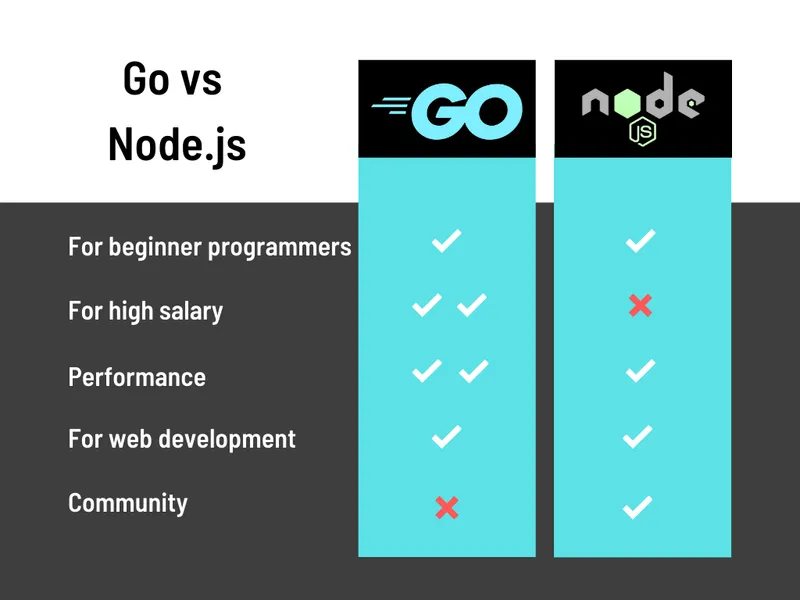
Golang vs Node.js: Which Is Better for Experienced Programmers? 🔗
Both tools have great benefits for experienced programmers.
If you already use JavaScript, then Node.js makes sense to adopt as an experienced programmer. It’s easier to learn a new “framework” rather than a whole language.
Node.js also has great reusability, which blends perfectly with its event-based applications, and uses JavaScript’s fastest engine, the V8, which can save you time when developing and running code on your servers. It’s popular for creating programs that use real-time processing, like video games and messaging.
Node.js’ main limitations for programmers are that it’s dynamically typed, which leads to poor error handling, and it runs in a single-threaded asynchronous environment, which can be confusing if you’re not comfortable with the style.
Golang has an easy learning curve too, but probably not as easy as Node.js, especially if you already have a decent understanding of JavaScript.
Golang’s strength lies in its streamlined concurrency and optimized memory management. Its clean code, garbage collector, and static type make error handling and writing manageable code a breeze.
Node.js offers JavaScript programmers the opportunity to do back-end web development as well as front-end, widening their skillset, but Golang may be a better option for those that need to learn a powerful back-end language that can scale in the cloud.
Node.js vs Golang Performance 🔗
This is where Node.js and Go’s differences really come into play.
One of the top marks for Golang is that it performs at a high level when it comes to speed and memory management, second only to low-level languages like C and Rust. With memory management tools like its garbage collector and native goroutines, Go programs thrive on a powerful yet minimalist structure.
Go also has a quicker startup and compile time because it is pre-compiled to machine code. JavaScript takes longer to execute because it’s dynamically typed and must be interpreted, while Go is statically typed and compiled, so it’s generally just faster.
In 2016, Uber even migrated from Node.js to Go to enhance their geofence look-up microservice, specifically because Go’s static typed and raw CPU performance suited Uber’s algorithms better, as well as the multithreading providing smoother resource usage.
The final results for Uber’s switch were 99.99% uptime and a peak load of 170,000 queries per second.
Node.js has its high points as well. It adopted a non-blocking and asynchronous system from JavaScript, which allows for small tasks to wait in the background that won’t affect the main thread – a crucial development as it only supports single thread. This is also how Node.js has the ability to seem like a multi-threaded language, without actually doing more than one operation at a time.
Node.js uses the V8 engine for fast processing and boasts a robust tech stack too.
A report was released from PayPal where they switched their back-end operations from Java to Node.js, which led to a 35% decrease in average response time, and pages were served 200ms faster.
In the end, Golang has better raw performance and stability, but in a workplace application, they both offer strong benefits.
Golang vs Node.js: Which Has a Higher Salary? 🔗
According to PayScale, Node.js developers earn a median salary of $91,198 a year in the US, and Go developers earn $117,394 a year.
There are a couple of reasons for such a deviation. The first being Golang is an entire programming language, whereas Node.js is an environment used by JavaScript developers, which only make an average of $84,219 a year generally.
Second, the JavaScript market is completely saturated with programmers, whereas Golang is still an untapped market. While JavaScript continues to be one of the most popular languages, Golang is one of the most wanted, so now’s the time to jump in and fill the demand.
Try out our Learn Go courses for free.
Go vs Node: Which Is Best for Web Development? 🔗
This is the field where both Node and Golang stake their claim.
Node.js was built to provide an environment where JavaScript could build front-end and back-end web servers in one place, with an event-based framework, microservices architecture, and great reusability.
NPM, the Node.js package manager, is the pièce de résistance of this whole operation, with 800,000 tools or “building blocks” dedicated to web development. However, the trick comes with navigating these blocks, as anyone can easily publish an NPM package, so it’s often difficult to find a trusted tool.
Node.js only starts to struggle when it comes to high computational loads. JavaScript is a front-end language that Node.js shoehorns into a backend run-time environment. While Node.js has put things in place to beef up its single-thread nature (a.k.a the nonblocking I/O and asynchronous system), heavy requests can still eat up CPU and slow down processing time.
Oppositely, Golang was developed for big network servers and heavy computations that Node.js simply can’t handle as well. It’s concurrent, so it doesn’t have to cut corners to run multiple processes at a time, making it efficient and fast for enterprise applications.
You can build entire web servers inside Go without the use of any extra frameworks or 3rd party services, and while it doesn’t have 800,000 blocks, it does have amazing features like go fmt, Godoc, go mod, and go run.
Go is also compiled into a single static binary, so you can drop the code where needed, whereas the Node.js interpreter needs to be installed on machines to provide an environment for JavaScript to run.
The takeaway, Golang is better for high-scale backend web development as it offers more flexibility and stability when it comes to building web servers, however, if you’re looking to run small projects, or to build front-end code bundles, then Node.js could be a more useful tool.
Go vs Node.js: Which Is Best for Machine Learning? 🔗
Node.js and Golang may seem like unusual choices for machine learning, given their extensive role in web development, but they both offer great resources.
Node.js alone does not offer machine learning or AI capabilities, but there are libraries you can use with Node as a way to integrate AI properties into your JavaScript projects. There are TorchJS, ONNX.js, and TensorFlow.js, but for the sake of this article, I’m going to use TensorFlow.js as an example. TensorFlow.js has the best support client and server-side, which is one of the big draws of Node.js.
TensorFlow.js is an open-source software library, and it allows you to create and use machine learning and deep learning models directly in Node.js. With it, you can create, train, and reuse models. You can also write the model in Python (a notable ML language) and import it to Node.js since Python has been supporting for training and research.
Node.js also calls for local running, which is an attractive feature if you’re worried about security risks and has GPU support for faster processing.
But this method is far from straightforward. There’s quite a lot of hoops to jump through, and even then, it may require the use of other languages to handle data that JavaScript doesn’t have the power to do.
Golang is much more lucid. It’s designed to handle large data sets, so no worries about needing other languages for support. It also has a lot of machine learning tools already built into its library, and native support tools help programmers develop models faster and easier. As far as TensorFlow goes, it has support for Golang when it comes to using models in production, but training and testing has yet to receive proper tooling.
As a concurrent language, Go also allows for multiple machine learning algorithms and programs to run simultaneously with superb speed and possesses an intuitive syntax. However, it does often lack more advanced features like GPU support.
Node.js is a better option for machine learning if you’re highly experienced with JavaScript and are focusing on smaller data sets, but if you’re handling big data and want something more succinct, then Go is the way to go – pun intended.
Node.js vs Golang: Which Has a Better Community? 🔗
JavaScript was developed in 1995, and while the Node runtime is much younger, it’s still a part of this massive 26-year-old community that’s full of beginner and experienced programmers.
This support is particularly useful when troubleshooting or learning new frameworks. Especially when it comes to more niche applications like machine learning, where it’s still quite new. That support ends up becoming integral to your programming process.
On the other hand, Golang’s community is still small and new.
It’s definitely growing in popularity, but it has yet to reach its full potential, especially in data science and machine learning. While the community may not have the experience to help with troubleshooting, you do have the opportunity to learn together.
Go vs Node.js: The Final Verdict 🔗
When it comes is deciding which tool is best, it really depends on your background.
If you’re an experienced JavaScript programmer, then using Node.js makes obvious sense. Node uses a language you already know and is a part of a massive community you’re already in! However, there is a chance of further down the line needing to learn a dedicated, high-performance back-end language.
If you aren’t familiar with JavaScript and are looking for a powerful server-side language to add to your toolbox, then Golang is an absolute must. It’s young and new, but it’s growing every day, and now is an exciting time to enter the community and flourishing job market, while demand is high, but supply is low.
Either way, Go and Node.js both offer serious value to your skillset and provide the opportunity to level up career-wise.
Take action and learn to code:
Learn JavaScript: with our Learn JavaScript. You’ll learn how computer science works, and build your skills up and code your own game interactively using conditionals, variables, functions, and more. You’ll gain the skills you need to eventually start using Node.js and other JS extras.
Learn Golang: with our Learn Go. Our Go course covers everything from the basics to advanced concepts like concurrency.
All our courses are part of our wider computer science curriculum to take anyone from complete beginner to CS grad level.
